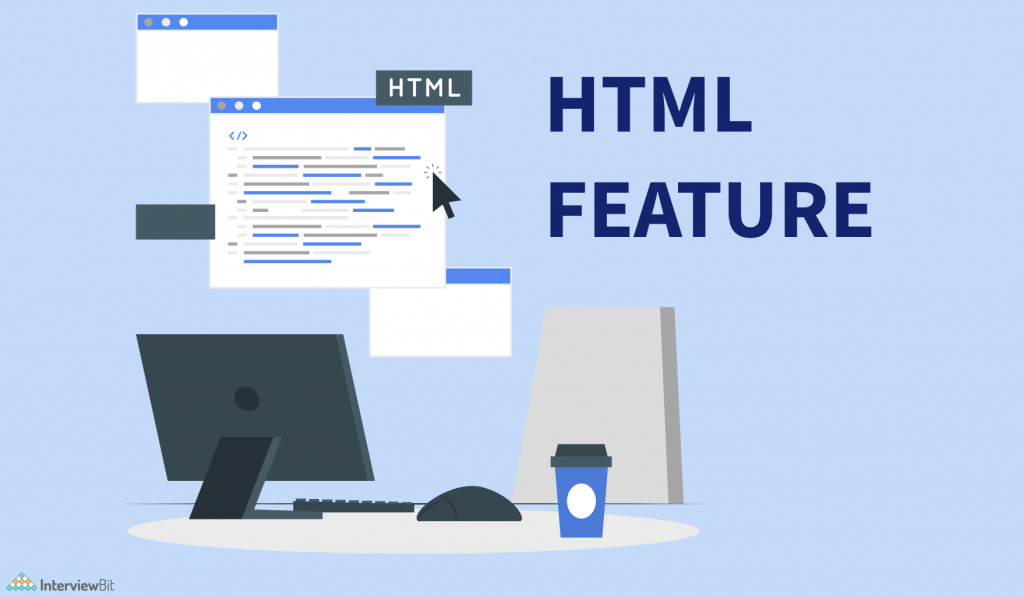- Introduction
- Popularity of HTML
- Why do you Need HTML?
- Top HTML Features
- 1. User Friendly & Simple
- 2. Semantic Structure
- 3. SEO – Search Engine Optimisation
- 4. localStorage & IndexedDB – Client-side data storage
- 5. Offline Capabilities (PWA) with Cache API & Service Workers
- 6. Canvas for Game Development
- 7. Platform Independent
- 8. Media Support
- Conclusion
- FAQs
- Q.1: What is HTML used for?
- Q.2: Why is HTML good?
- Q.3: What professionals use HTML?
- Q.4: Is HTML easier than Python?
- Q.3: Why is HTML not a programming language?
- Q.4: Will HTML become obsolete?
- Additional Resources
Introduction
With the advent of high-performing internet-enabled devices, HTML has become a popular term. However, what is HTML, and how did it become so crucial for the whole internet? HTML stands for HyperText Markup Language. Now, what’s a Markup Language, you ask? You can use Markup languages to format the text to provide a visual structure to the document. This page, for example, is also an HTML. HTML belongs to the family of XML (Extensible Markup Language), which uses a set of codes or tags to describe the text in a document. Think of HTML as XML on steroids, which the browser understands how to represent visually.
HTML is one of the biggest reasons the internet has become what it is today. You can use HTML to build websites, and the ease and simplicity of HTML enable many to develop and build websites. However, it has allowed its users to share web documents seamlessly ever since its inception. These days, Web Developers use it to create excellent web applications while coupling it with JavaScript and a Backend. HTML is something one cannot live without if one works on a computer.
Popularity of HTML
When Tim Berners Lee came up with a proposal that allowed easy sharing of documents at CERN in 1980, he probably didn’t know that HTML would become the literal backbone of the internet we know and love. The most current and widely used version of HTML is HTML5. The W3C (World Wide Web Consortium) published the older versions as per the RFC (Request for Comments). The World Wide Web Consortium, or W3C for short, is an international community responsible for developing open standards to ensure the long-term growth of the Web. They do so via RFCs (Request for Comments), which in turn is authored by prominent groups of engineers and computer scientists and individuals. When browser vendors adopt these RFCs, they become standards and browsers like Chrome, Firefox, and Safari implement them. Pretty democratic, eh?
Confused about your next job?
One could say that since W3C takes concern of so many opinions, HTML is therefore widely used and adopted. HTML is easy to learn and write because it is human-readable. The ease of learning and developing HTML websites makes it very popular.
Why do you Need HTML?
If you are building a web application for any user, HTML is simply the only option with respect to the Frontend for the Web. Abstractions like HAML, Jade, etc., are considered to be alternatives to HTML; however, even these abstractions are eventually converted to HTML because that’s what the browser understands! So, if you’re looking to wow your audience, HTML along with CSS(Cascaded Style Sheets) makes a good case for itself. Think of CSS as a make-up artist and HTML as the actor, HTML brings the talent, but it looks plain without CSS!
Another fantastic thing about HTML is how easy it is to deploy a website. There are so many tools available at your disposal these days that make it super simple to build and then update your website. As the basic structure of the web page is created using HTML, with the advent of (Content Management Systems), CMS like WordPress, etc., building a website is now a superpower that almost any average person with a Computer has. You don’t need to be a developer anymore to build a website. But, if you wanted to, you could still learn HTML and create your first web page within the day.
Top HTML Features

HTML has so many features that it took multiple RFCs (Request for Comments) to describe every part. It would be almost impossible to go through all the features in this article. However, we will go through the most popular ones that come in handy in a developer’s life.
1. User Friendly & Simple
You can write HTML using annotations called tags. Tags give HTML a structure and make it easy for humans and browsers to read the document efficiently. They also enable a browser to apply CSS (Cascaded StyleSheets) to the digital document, making it a powerful visual combination.
While HTML comes with 100s of tags inbuilt, only a handful of them that a developer needs to learn for everyday use. Of course, all tags hold value; most of them don’t find usage in normal development.
2. Semantic Structure
HTML5 defines unique tags to annotate different elements for their specific purposes. The <article> tag, for example, is used to annotate content on a page. The <aside> tag represents some content that is indirectly related to the document’s primary content. Other noteworthy elements are <header>, <footer>, <div>, the paragraph tag <p>, and the one most used for navigation between pages, the <a> tag.
3. SEO – Search Engine Optimisation
SEO is by far the biggest USP (Unique Selling Point) of HTML5. With the advent of search engines like Google, Yahoo!, DuckDuckGo etc., you have so much information literally at your fingertips. These search engines accumulate information on the World Wide Web using computer programs that crawl the internet (also called web crawlers) and map keywords with respective documents in which they find it. These web crawlers can assimilate this data only because HTML is well structured, and you can optimise your web pages for searchability.
To highlight SEO, let me bring to your attention that this page is also SEO optimised and should appear for the search query “Top features of HTML”. You can even make use of the semantic structure of HTML for Search Engines using tags like <title>, <meta> with description, <header> etc., to let the web crawler know about the critical keywords in the document.
4. localStorage & IndexedDB – Client-side data storage
HTML5 comes with essential improvements in storage capabilities on the client’s side. The localStorage and sessionStorage are crucial features that help developers store information on the client’s side. These are essential advancements in browser storage capabilities because cookies limit data storage size on the client side. One can store small pieces of information like authentication tokens or usernames on the client using cookies. Still, localStorage API is where storage comes in handy for users when they revisit the web application. Imagine not having to repeatedly load some standard information on the client, which saves a lot of resources for both client and server. The sessionStorage API enables a developer to persist information just for that session. Meaning, the data is wiped out as soon as the user closes that tab. This feature comes in handy for browser-based games or high-security applications that have a limited session.
IndexedDB takes client-side storage a step beyond what localStorage does. While you could potentially store a lot of data with localStorage in a key-value form where both are strings, you can store more complex and significant data in the key-value form using IndexedDB. The key is a string, and the value to be stored is a native JavaScript object. Oh, and this object will persist through the IndexedDB until someone explicitly removes it.
IndexedDB enables the web application to store data on the client-side, i.e. the browser, and allows your web application to continue functioning even with flaky or a dropped internet connection. Let us talk more about this in the next feature.
5. Offline Capabilities (PWA) with Cache API & Service Workers
Imagine if you could build a web application that works even when the user’s internet is down. Well, you don’t have to imagine because, with the advent of Service Workers, IndexedDB and Cache API, you could very well make this a reality. Your web application could offer a native-like experience to your users. Many applications like Flipkart already do this, and it’s called a PWA (Progressive Web Application).
Service Workers act as a proxy between the user’s machine and the internet. They can store files locally and fetch them when needed via the Cache API and can also bring information from the IndexedDB to provide the application with data. So, when there’s no internet on a user’s device, the Service Worker intercepts these requests and serves them from the locally stored data. You can configure your service worker to update these files periodically or on-demand.
6. Canvas for Game Development
You can use HTML5 to build some simple games; however, if you’re looking to make a good video game, you can utilise the <canvas> element along with CSS and JavaScript. Canvas enables you to build 2D and 3D games. You can make these games as interactive as you’d like.
7. Platform Independent
HTML runs on a browser, and you can find a browser on almost any device with a simple Operating System. If you had used mobile phones before smartphones were a thing, you would know that even old Nokia phones that ran Symbian OS could open HTML pages.
8. Media Support
HTML can display images, video and audio; therefore, it enjoys excellent media-running capabilities. HTML5 came up with <video> and <audio> tags making this a lot easier than before. Of course, with HTML5, you can go beyond just playing media; you can specify controls, images for buttons and even control the playback programmatically.
The <figure> tag also deserves a special mention because it has revolutionised rendering images on a browser. You can also represent captions using the <figcaption> tag along with the <figure> tag.
Conclusion
HTML can be your biggest ally once you dive into it. Many businesses like eBay, Amazon and so on relied only on HTML in the beginning. HTML is a low investment, high return in terms of the features it offers. There are plenty of careers that require the know-how of HTML, like Frontend Engineer, SEO Specialist, etc.
FAQs
Q.1: What is HTML used for?
Ans: The use cases of HTML are not limited to building web pages, creating blogs and navigating the internet. You can use HTML to build massive businesses and make highly interactive websites. There are plenty of famous games that use only HTML Canvas!
Q.2: Why is HTML good?
Ans: HTML is pretty simple and easy to start. The return on investment in learning HTML is high. Simply put, HTML is suitable for building websites, sharing digital documents, and so many more things on the Web. If you want to do something with the internet, HTML is a must-know!
Q.3: What professionals use HTML?
Ans: Frontend Engineers, User Interface Developers and SEO specialists use HTML regularly. User Experience Designers also know the basic semantic structure of a web page, and it helps them build highly interactive web applications. Marketing professionals use HTML to create user engagement using blogs and email templates.
Q.4: Is HTML easier than Python?
Ans: Programmers might find Python more intuitive to understand; however, HTML and Python serve very different use cases. One can learn Python if they’re more interested in Data Science. To conclude, if you gave the two tasks of learning HTML and Python to someone who doesn’t know any programming, they would find HTML much more straightforward and intuitive.
Q.3: Why is HTML not a programming language?
Ans: HTML is a markup language that merely communicates the structure of a digital document to the browser, and the browser, in turn, can visually represent that structure.
A programming language is something that instructs the machine to perform specific tasks. HTML is just a representation of information in a human-friendly manner.
Q.4: Will HTML become obsolete?
Ans: When native mobile apps on Android and iOS became more mainstream, a widespread consensus was that these applications would reduce HTML adoption. Since then, HTML has evolved, its usage has grown further, and it is likely to stay. There are no new developments that have happened that would suggest otherwise.




